John Walley - Fresh Ideas for a Productive Economy

Paper for Fabians Seminar "Fresh Ideas for a
Productive Economy"
July 2011 - Legislative Chamber, NZ
Parliament
By John Walley
John Walley – Manufacturers and Exporters Association
Issues
Recently the Prime Minister stated during a presentation that, “if I could I would have a 50 cent (as opposed to an 80 cent) dollar tomorrow”. If that were really the case, what would be the macroeconomic framework? What we have or something else?
The macroeconomic policy settings we have now tend to overvalue the New Zealand dollar which is driven more by the weight of capital flows (some 400x trade flows) rather than any reference to trade flows. That bias has consequences that we can see in the real economy.
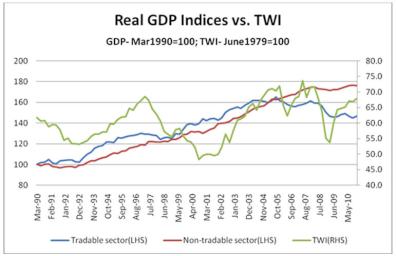
Click for big version
A bias towards a high currency favours consumption: the often heard “yes the dollar is high but foreign holidays and imports are cheap”. A bias to a low currency favours producers – we have the balance wrong.
The tendency to overvalue the New Zealand dollar, characterised as inevitable by many, has a serious and long term fallout. Investment is stymied when returns are unpredictable and as we trade away the “added value” component all that remains to live on is the commodity base. Is that sufficient?
Instinctively agriculture and tourism are real strengths of the New Zealand’s economy, but looking at the numbers manufacturing makes a larger contribution to the economy. Manufacturing in these numbers includes the added value component associated with processed commodities; increasingly that component is being traded away by the currency appreciation. The automatic stabilisation claimed to be associated with a floating exchange rate regime (an adverse external demand shock reduces net exports, the falling interest rate will lead to exchange rate depreciation, as a result the balance of trade improves, hence the floating exchange rate blunts the adverse impact and vice versa) operates largely on commodities and not at all on elaborate goods."

Click for big version
As might be expected the makeup of our economy is reflected in the make-up of our exports, again this emphasises the relatively small part of the economy and exports are subject to the automatic stabiliser mechanism.
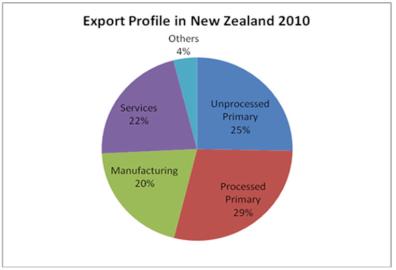
Click for big version
Even with the current diversity (it is falling all the time) of exports we find ourselves unwilling or unable to balance our current account, that creates a need to source capital from overseas to make up the difference and that puts upward pressure on the exchange rate. We are doing much worse than other nations in this regard, and clearly we should be focused on expanding the real economy rather than claiming that on-going losses are inevitable.
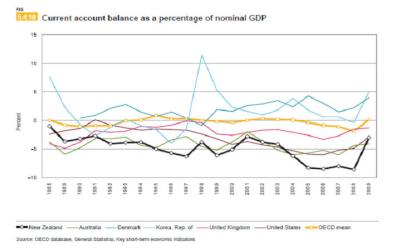
Click for big version
Current account deficits span decades and governments, this is not a new problem; sooner or later the cumulative impact will see the cost of offshore borrowing increase, government spending under pressure, asset sales and ultimately a less attractive and therefore lower value currency. Sadly by then the damage will be done to the added value sector.
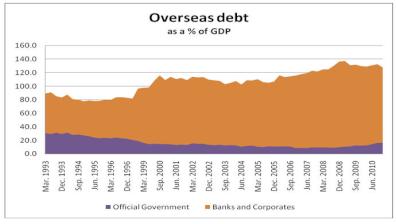
Click for big version
Growth in the real economy requires investment, investment will simply not happen unless returns from exports are more predictable. Other economies demonstrate that currency fluctuations are not entirely inevitable; they are an outcome of macroeconomic policy interacting with the global economy.
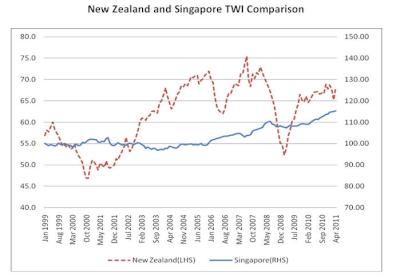
Click for big version
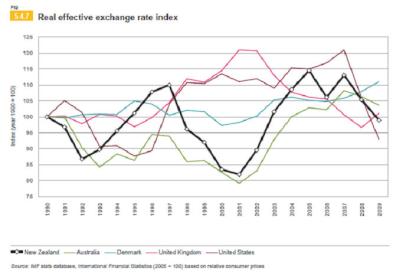
Click for big version
Would there be any serious argument which economy, Singapore or New Zealand, has done better economically over the past twenty odd years? As mentioned earlier an overvalued currency tends to trade away the added value element sold into a particular market. The difference is commodity prices are set by demand, but added value prices are set by competition. Elaborate products are priced into the markets in which they compete; consequently returns in a particular market are intermediated by the exchange rate offset by whatever natural hedge might be in place.
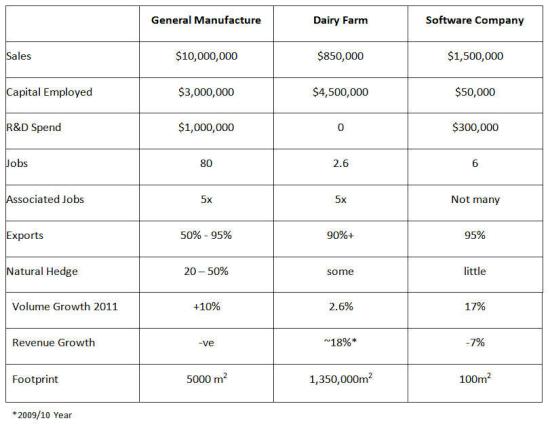
Click for big version
These examples are given to demonstrate that when we are willing to allow an overvalued exchange rate to trade away the added value margin there is no return to be expected from investment in added value, equipment, plant, research and development. As a result our economy simplifies and regresses to, at best, simply processed commodities.
With around NZ$40b of annual exports, a one percent increase in our exchange rate has a net annual cost to exporters of $200 million, this includes the assumption that 50% of sales are sourced in currencies other than the NZ$. The high to low range thus far in 2011 is 20%!
Investment in the expansion of the real economy, in volume and complexity, depends on a realistically valued, less volatile currency. Does it matter where that investment goes? Other jurisdictions seem to think so; they direct fiscal policy towards what are seen as desirable activities. Direct comparisons are difficult: military spending and favourable treatment of depreciation in productive assets are common interventions; one broad indicator of intent are targeted interventions in the area of research and development.
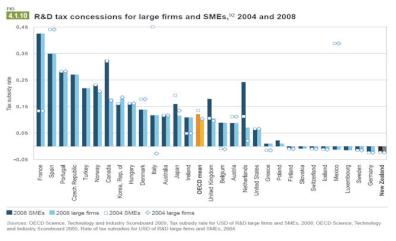
Click for big version
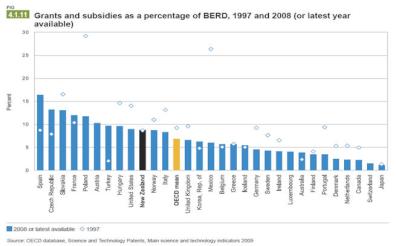
Click for big version
Opportunities
#1 Monetary Policy
When the Reserve Bank Act was introduced in 1989 it was designed to control the inflation problems of the 1970s and 80s. It seemed to work for most of the 1990s, but global inflation had subsided by this point in any case.
The problem with using the Official Cash Rate (OCR) to curb inflationary pressures has been its ineffectiveness in preventing inflation in the non-traded sector. As the graph below shows non-tradeable inflation has been outside of the target band for most of the last decade.
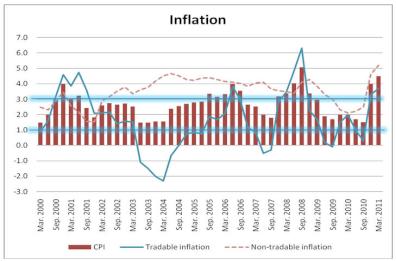
Click for big version
The price of credit has proven to be an ineffective regulator of domestic demand. An increase of say two percent in the price of mortgage credit is fairly insignificant if house prices are expected to increase between 10 and 20 percent. This has meant that the tradeable sector, which has caused little inflationary pressure, has worn the brunt of OCR hikes through their impact on the exchange rate.
The exchange rate volatility has increased over the period since the OCR was introduced. Interest rate differentials between New Zealand’s OCR and the official interest rates elsewhere and the bias towards leveraged asset investment have largely driven this volatility.
Given that the price of credit has not been effective in reducing non-tradeable inflation, regulatory controls on the supply of or demand for credit are necessary. Controlling the credit supply from overseas through measures such as the Core Funding Ratio that the Reserve Bank has already introduced is one option, but the controls must be much tighter and there needs to be an effort to ensure that the banks do not circumvent the rules. A Loan to Value Ratio would restrict demand for credit by enforcing a minimum percentage of deposit for borrowing. Zero percent deposits have been a major cause of the increase in household borrowing and property bubbles.
#2 Local Fiscal Policy
Despite some changes last year to increase GST and reduce personal and corporate tax, New Zealand’s tax system is still unbalanced. Too much of the tax load is carried by personal and corporate tax while capital gains on assets are largely untaxed.
It is difficult to understand the rationale behind this system. Investment in assets produces little for the economy while investment in businesses provides better jobs, higher incomes and more tax for the Government.
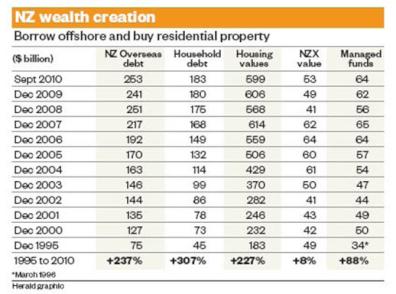
Click for big version
This table created by Brian Gaynor in his Herald article shows the misallocation of borrowing towards household debt, the lack of investment in firms through the NZX and the overall effect on our overseas debt position. It is no wonder that productivity in New Zealand is low when businesses are starved of capital as asset investments are so advantaged. The $47 billion dollar rural debt problem reported in the Herald is a classic case of this where investment in assets far outstripped their earning potential.
The Capital Gains Tax or Land Tax that the Tax Working Group recommended in 2010 is necessary to deal with the tax harbour around property.
#3 Fiscal Policy response to incentives elsewhere.
The only justification for fiscal incentives is to level the competitive playing field and match what is offered by New Zealand’s competitors. Overseas we see Research and Development Tax Credits, fast write off for investment, personal tax breaks for early stage business investment and export development loans. These need to be matched here so that our tradeable sector is on an even footing with overseas firms.
Overall, the decision the bias we place on the external of our dollar with our policy framework, towards 50 cents or towards 80 cents, the former gives the real economy a chance and is sustainable in the medium term, the latter feels good for many but will lead to low growth and our continued slide down the OECD rankings as our real economy, robbed of an ability to earn a return from added value, regresses to its commodity base and we are all the poorer for that.
 John Walley is an
experienced shareholder, director, manager and technologist
with significant international experience in strategy,
technology, product development, operations and intellectual
property management.
John Walley is an
experienced shareholder, director, manager and technologist
with significant international experience in strategy,
technology, product development, operations and intellectual
property management.
John was previously a business
development and engineering director at Gallagher, a
director of Industrial Research, Stabi-Craft Marine, and
chair of Canterprise, Nanotechnology Devices and
Prolificx.
Six years as a Crown Research Director,
thirteen years as an active member of the Technology New
Zealand reference group, and many years experience in
manufacturing and new product development gives John a broad
and pragmatic view of the world.
He has taught commercial
innovation papers on the University of Waikato Master of
Business Administration programme.
Currently, in addition
to being a director Imarda, he is a director of Hamer, a
director and shareholder of Powerhouse, and a Chair and
shareholder of Horotane Investments and ProActive Software
Limited.
John is also a founder and shareholder of
several other companies that offer software as service
solutions in the psychological testing, systems compliance
and medical device domains.
He consults to a number of
companies in South Africa, USA, Australia, UK and
France.
Mistakes, failures and sufficient success for
hope to transcend experience form a long-term commitment to
the development of the high technology manufacturing sector
in New Zealand; this drives him in his role as Chief
Executive of the New Zealand Manufacturers and Exporters
Association.
John has an Honours Degree in Electrical
Engineering, is a Chartered Engineer, a Fellow of the
Institute of Professional Engineers NZ, a Fellow of the
Institute of Management NZ and a Member of the Institute of
Electrical Engineers in the
UK.


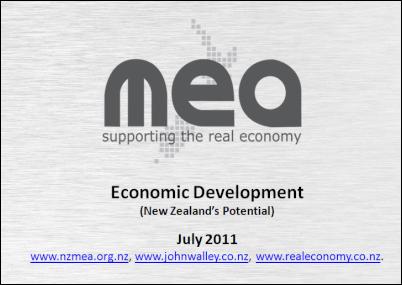
 Richard S. Ehrlich: Deadly Border Feud Between Thailand & Cambodia
Richard S. Ehrlich: Deadly Border Feud Between Thailand & Cambodia Gordon Campbell: On Free Speech And Anti-Semitism
Gordon Campbell: On Free Speech And Anti-Semitism Ian Powell: The Disgrace Of The Hospice Care Funding Scandal
Ian Powell: The Disgrace Of The Hospice Care Funding Scandal Binoy Kampmark: Catching Israel Out - Gaza And The Madleen “Selfie” Protest
Binoy Kampmark: Catching Israel Out - Gaza And The Madleen “Selfie” Protest Ramzy Baroud: Gaza's 'Humanitarian' Façade - A Deceptive Ploy Unravels
Ramzy Baroud: Gaza's 'Humanitarian' Façade - A Deceptive Ploy Unravels Keith Rankin: Remembering New Zealand's Missing Tragedy
Keith Rankin: Remembering New Zealand's Missing Tragedy